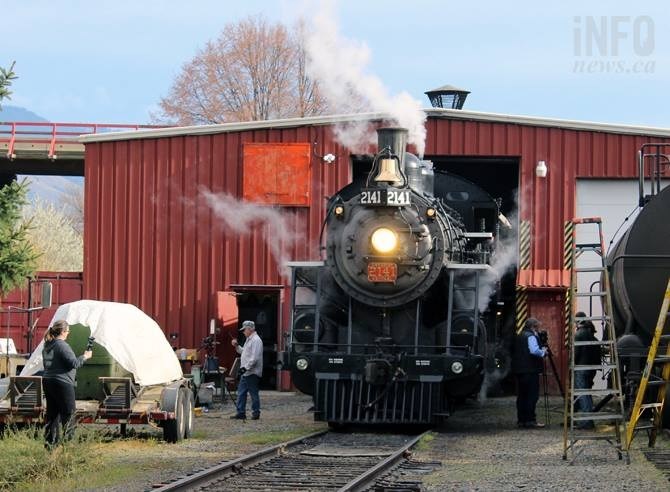
Members of the Arc/k Project surround the Kamloops Heritage Railway's 2141 locomotive, taking thousands of images to create a highly detailed 3D digital model.
(BRENDAN KERGIN / iNFOnews.ca)
November 15, 2016 - 9:00 PM
KAMLOOPS - Some of the most important cultural and historic items in Kamloops have just had their picture taken. Actually, thousands of photos taken.
The Arc/K Project was in Kamloops last week taking photos of the Kamloops Heritage Railway’s 2141 locomotive and items at the Secwepemc Museum. Project leader and founder Brain Pope says the photos will be turned into extremely detailed 3D digital models for the use of the organizations that own the originals.
“Digital technologies can add new forms of revenue,” he says. “There’s a digital gold rush out there. There are companies trying to profit.”
The photos are put together using photogrammetry software to produce high resolution digital models that can be used to create physical reproductions with a 3D printer or in films.
The Arc/k Project is an American based organization created to help not-for-profit organizations or others not familiar with the technology availble to create permanent digital records of their physical artifacts. With the project is just over a year old, one of the first places Pope came to was the Kamloops region after visiting the area years ago while working on a project about ghost towns.
Additionally, Pope, who has Apache and Cherokee heritage, is interested in places with an active First Nations culture.
“It’s always interesting to me to go to a region where that culture is still alive,” he says.
Part of the project in Kamloops was to teach members of the Secwepemc nation the skills to create models themselves through photogrammetry. The hope is the skills will be passed on to others and more objects can be recorded creating a huge archive of culturally important historical items.
"It doesn’t have to be super expensive and rarified technology," he says. "It can be done by any lay person."
Pope says the plan is to use the 2141 locomotive in future conferences and presentations as an example to the world about what can be achieved through new technology. The digital model will be the property of the heritage railway society though, and may be used in films or to create toys, offering the not-for-profit organization new revenue streams.
The process takes some time, as Pope and his crew took 1.5 terabytes of photos of the locomotive alone, including shots of it in motion with steam around it. A variety of cameras were used, including a RED Dragon, a super high end camera worth thousands of dollars.
Pope foresees this as a new way for similar organizations around the world to make money, as long as the organizations are able to retain ownership of the digital models.
“These organizations can be liberated, can control how they reach out to the world. This is about those institutions be empowered,” he says. "Unfortunately when you rely on just charity or academia to preserve heritage a lot can get lost.”
There’s sometimes knowledge gap for those who are in control of objects and digital models. Pope says some companies are charging organizations tens of thousands of dollars to create the models. Additionally some for profit companies will retain the digital models copyright, so that it can then profit on the model’s use.
“I think we need to be careful that the organizations we’re putting our faith in are holding themselves to the highest standards,” he says. “It’s important we warn people, don’t sell your cultural heritage short.”
Also, while government organizations like the City of Los Angeles and UNESCO have expressed interest in the project, he says they're slow moving bureaucracies uncertain about the new technology.
Pope is hoping to help create digital archaeology as well, so sites, like the city of Palmyra which was destroyed by ISIS, can be saved from natural disaster and human destruction.
“We culled 1000s of photos of Palmyra,” he says. “We were able to generate three different models of this ancient city. We put these academics into that simulation and allowed them to walk on these now extinct stones.”
It was Palmyra's destruction in the summer of 2015 that spurred Pope to create the project. Currently the project is funded by Pope, who has worked in the visual effects field in Hollywood for years.
"I wanted us to have a safe place to evolve," he says. "But we do have to transition that eventually."
Pope and his crew left Kamloops on Friday, Nov. 11, though he hopes to return in the future. He’s currently trying to make a film of his own, and would like to shoot in the Kamloops region.
To contact a reporter for this story, email Brendan Kergin or call 250-819-6089 or email the editor. You can also submit photos, videos or news tips to the newsroom and be entered to win a monthly prize draw.
We welcome your comments and opinions on our stories but play nice. We won't censor or delete comments unless they contain off-topic statements or links, unnecessary vulgarity, false facts, spam or obviously fake profiles. If you have any concerns about what you see in comments, email the editor in the link above.
News from © iNFOnews, 2016